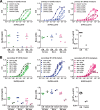Potent Neutralizing Human Monoclonal Antibodies Preferentially Target Mature Dengue Virus Particles: Implication for Novel Strategy for Dengue Vaccine
- PMID: 30185598
- PMCID: PMC6232466
- DOI: 10.1128/JVI.00556-18
Potent Neutralizing Human Monoclonal Antibodies Preferentially Target Mature Dengue Virus Particles: Implication for Novel Strategy for Dengue Vaccine
Abstract
The four serotypes of dengue virus (DENV) cause the most important mosquito-borne viral disease in humans. The envelope (E) protein is the major target of neutralizing antibodies and contains 3 domains (domain I [DI], DII, and DIII). Recent studies reported that human monoclonal antibodies (MAbs) recognizing DIII, the D1/DII hinge, the E-dimer epitope, or a quaternary epitope involving DI/DII/DIII are more potently neutralizing than those recognizing the fusion loop (FL) of DII. Due to inefficient cleavage of the premembrane protein, DENV suspensions consist of a mixture of mature, immature, and partially immature particles. We investigated the neutralization and binding of 22 human MAbs to DENV serotype 1 (DENV1) virions with differential maturation status. Compared with FL MAbs, DIII, DI/DII hinge, and E-dimer epitope MAbs showed higher maximum binding and avidity to mature particles relative to immature particles; this feature may contribute to the strong neutralizing potency of such MAbs. FL-specific MAbs required 57 to 87% occupancy on mature particles to achieve half-maximal neutralization (NT50), whereas the potently neutralizing MAbs achieved NT50 states at 20 to 38% occupancy. Analysis of the MAb repertoire and polyclonal sera from patients with primary DENV1 infection supports the immunodominance of cross-reactive anti-E antibodies over type-specific antibodies. After depletion with viral particles from a heterologous DENV serotype, the type-specific neutralizing antibodies remained and showed binding features shared by potent neutralizing MAbs. Taken together, these findings suggest that the use of homogeneous mature DENV particles as an immunogen may induce more potent neutralizing antibodies against DENV than the use of immature or mixed particles.IMPORTANCE With an estimated 390 million infections per year, the four serotypes of dengue virus (DENV) cause the most important mosquito-borne viral disease in humans. The dengue vaccine Dengvaxia was licensed; however, its low efficacy among dengue-naive individuals and increased risk of causing severe dengue in children highlight the need for a better understanding of the role of human antibodies in immunity against DENV. DENV suspensions contain mature, immature, and partially immature particles. We investigated the binding of 22 human monoclonal antibodies (MAbs) to the DENV envelope protein on particles with different maturation states. Potently neutralizing MAbs had higher relative maximum binding and avidity to mature particles than weakly neutralizing MAbs. This was supported by analysis of MAb repertoires and polyclonal sera from patients with primary DENV infection. Together, these findings suggest that mature particles may be the optimal form of presentation of the envelope protein to induce more potent neutralizing antibodies against DENV.
Keywords: dengue virus; envelope; mature particles; monoclonal antibody; neutralization.
Copyright © 2018 American Society for Microbiology.
Figures







Similar articles
-
High-avidity and potently neutralizing cross-reactive human monoclonal antibodies derived from secondary dengue virus infection.J Virol. 2013 Dec;87(23):12562-75. doi: 10.1128/JVI.00871-13. Epub 2013 Sep 11. J Virol. 2013. PMID: 24027331 Free PMC article.
-
The potent and broadly neutralizing human dengue virus-specific monoclonal antibody 1C19 reveals a unique cross-reactive epitope on the bc loop of domain II of the envelope protein.mBio. 2013 Nov 19;4(6):e00873-13. doi: 10.1128/mBio.00873-13. mBio. 2013. PMID: 24255124 Free PMC article.
-
Identification of human neutralizing antibodies that bind to complex epitopes on dengue virions.Proc Natl Acad Sci U S A. 2012 May 8;109(19):7439-44. doi: 10.1073/pnas.1200566109. Epub 2012 Apr 12. Proc Natl Acad Sci U S A. 2012. PMID: 22499787 Free PMC article.
-
The human antibody response to dengue virus infection.Viruses. 2011 Dec;3(12):2374-95. doi: 10.3390/v3122374. Epub 2011 Nov 25. Viruses. 2011. PMID: 22355444 Free PMC article. Review.
-
Does structurally-mature dengue virion matter in vaccine preparation in post-Dengvaxia era?Hum Vaccin Immunother. 2019;15(10):2328-2336. doi: 10.1080/21645515.2019.1643676. Epub 2019 Aug 23. Hum Vaccin Immunother. 2019. PMID: 31314657 Free PMC article. Review.
Cited by
-
A real-time and high-throughput neutralization test based on SARS-CoV-2 pseudovirus containing monomeric infrared fluorescent protein as reporter.Emerg Microbes Infect. 2021 Dec;10(1):894-904. doi: 10.1080/22221751.2021.1925163. Emerg Microbes Infect. 2021. PMID: 33929934 Free PMC article.
-
In Vivo Electroporation of Plasmid DNA: A Promising Strategy for Rapid, Inexpensive, and Flexible Delivery of Anti-Viral Monoclonal Antibodies.Pharmaceutics. 2021 Nov 6;13(11):1882. doi: 10.3390/pharmaceutics13111882. Pharmaceutics. 2021. PMID: 34834297 Free PMC article. Review.
-
A quantitative luciferase-based cell-cell fusion assay to measure four-serotype dengue virus E protein-triggered membrane fusion.Hum Vaccin Immunother. 2020 Sep 1;16(9):2176-2182. doi: 10.1080/21645515.2020.1748989. Epub 2020 Jun 12. Hum Vaccin Immunother. 2020. PMID: 32530355 Free PMC article.
-
An affinity-matured human monoclonal antibody targeting fusion loop epitope of dengue virus with in vivo therapeutic potency.Sci Rep. 2021 Jun 21;11(1):12987. doi: 10.1038/s41598-021-92403-9. Sci Rep. 2021. PMID: 34155267 Free PMC article.
-
Implications of Dengue Virus Maturation on Vaccine Induced Humoral Immunity in Mice.Viruses. 2021 Sep 15;13(9):1843. doi: 10.3390/v13091843. Viruses. 2021. PMID: 34578424 Free PMC article.
References
-
- Bhatt S, Gething PW, Brady OJ, Messina JP, Farlow AW, Moyes CL, Drake JM, Brownstein JS, Hoen AG, Sankoh O, Myers MF, George DB, Jaenisch T, Wint GR, Simmons CP, Scott TW, Farrar JJ, Hay SI. 2013. The global distribution and burden of dengue. Nature 496:504–507. doi:10.1038/nature12060. - DOI - PMC - PubMed
-
- World Health Organization. 2009. Dengue hemorrhagic fever: diagnosis, treatment, prevention and control, 3rd ed World Health Organization, Geneva, Switzerland.
Publication types
MeSH terms
Substances
Grants and funding
LinkOut - more resources
Full Text Sources
Other Literature Sources
Medical
Research Materials

